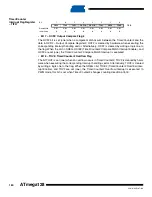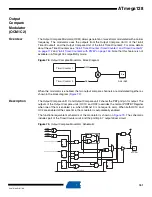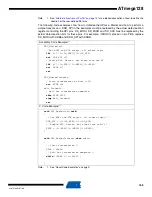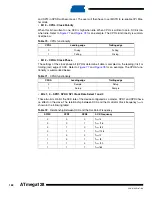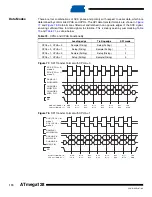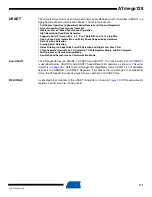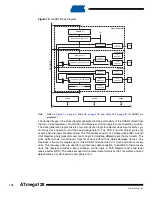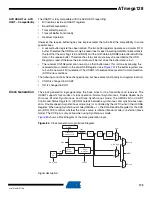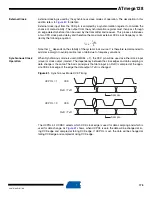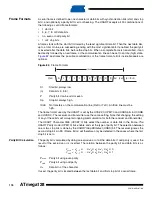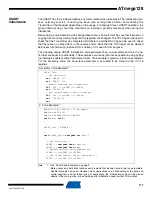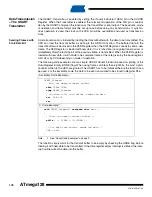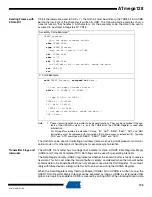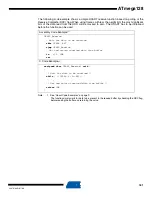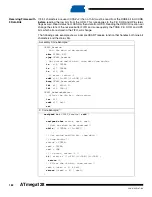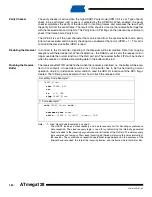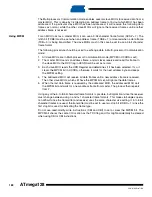
174
2467S–AVR–07/09
ATmega128
txclk
Transmitter clock. (Internal Signal)
rxclk
Receiver base clock. (Internal Signal)
xcki
Input from XCK pin (internal Signal). Used for synchronous slave operation.
xcko
Clock output to XCK pin (Internal Signal). Used for synchronous master
operation.
fosc
XTAL pin frequency (System Clock).
Internal Clock
Generation – The
Baud Rate Generator
Internal clock generation is used for the asynchronous and the synchronous master modes of
operation. The description in this section refers to
The USART Baud Rate Register (UBRR) and the down-counter connected to it function as a
programmable prescaler or baud rate generator. The down-counter, running at system clock
(fosc), is loaded with the UBRR value each time the counter has counted down to zero or when
the UBRRL Register is written. A clock is generated each time the counter reaches zero. This
clock is the baud rate generator clock output (= fosc/(UBRR+1)). The transmitter divides the
baud rate generator clock output by 2, 8, or 16 depending on mode. The baud rate generator
output is used directly by the receiver’s clock and data recovery units. However, the recovery
units use a state machine that uses 2, 8, or 16 states depending on mode set by the state of the
UMSEL, U2X and DDR_XCK bits.
contains equations for calculating the baud rate (in bits per second) and for calculating
the UBRR value for each mode of operation using an internally generated clock source.
Note:
1. The baud rate is defined to be the transfer rate in bit per second (bps).
BAUD Baud rate (in bits per second, bps)
f
OSC
System Oscillator clock frequency
UBRR Contents of the UBRRH and UBRRL Registers, (0 - 4095)
Some examples of UBRR values for some system clock frequencies are found in
).
Double Speed
Operation (U2X)
The transfer rate can be doubled by setting the U2X bit in UCSRA. Setting this bit only has effect
for the asynchronous operation. Set this bit to zero when using synchronous operation.
Setting this bit will reduce the divisor of the baud rate divider from 16 to 8, effectively doubling
the transfer rate for asynchronous communication. Note however that the receiver will in this
case only use half the number of samples (reduced from 16 to 8) for data sampling and clock
recovery, and therefore a more accurate baud rate setting and system clock are required when
this mode is used. For the Transmitter, there are no downsides.
Table 74.
Equations for Calculating Baud Rate Register Setting
Operating Mode
Equation for Calculating
Equation for Calculating
UBRR Value
Asynchronous Normal Mode
(U2X = 0)
Asynchronous Double Speed
Mode (U2X = 1)
Synchronous Master Mode
BAUD
f
OSC
16
UBRR
1
+
(
)
---------------------------------------
=
UBRR
f
OSC
16
BAUD
------------------------
1
–
=
BAUD
f
OSC
8
UBRR
1
+
(
)
-----------------------------------
=
UBRR
f
OSC
8
BAUD
--------------------
1
–
=
BAUD
f
OSC
2
UBRR
1
+
(
)
-----------------------------------
=
UBRR
f
OSC
2
BAUD
--------------------
1
–
=

